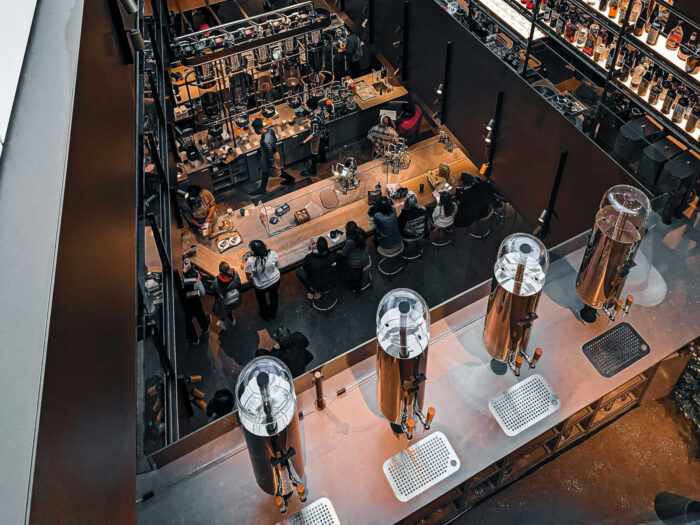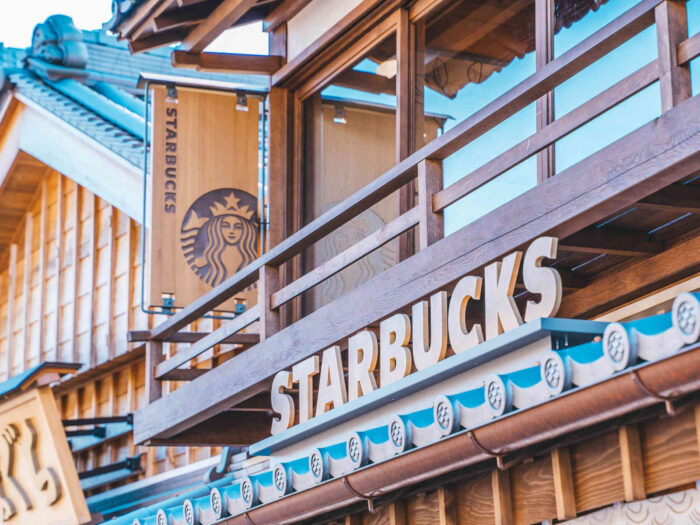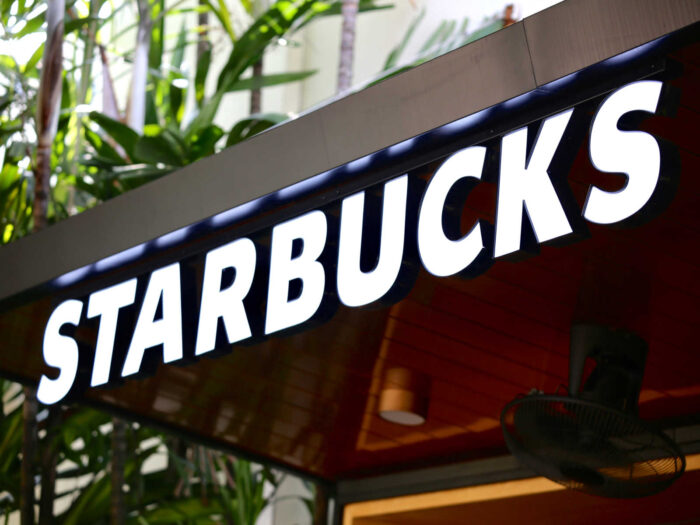
Starbucks Corporation (Starbucks Coffee Company) grows its multinational operations through a generic competitive strategy that highlights product specialty. In Michael Porter’s model, this generic competitive strategy focuses on setting the coffee business apart from competitors.
On the other hand, a combination of intensive growth strategies influences Starbucks’ growth and expansion. Based on Igor Ansoff’s matrix, these intensive growth strategies relate to the company’s generic strategy for competitive positioning in the coffeehouse market.
The intensive growth strategies align with the generic strategy to maximize Starbucks’ competitive advantages in an increasingly saturated global market for coffee and other beverages.
Starbucks’ generic strategy for competitive advantage and strategies for intensive growth support success against competitors, like Tim Hortons, as well as McDonald’s, Dunkin’, Wendy’s, Subway, and Burger King.
In the industry environment described in the Five Forces analysis of Starbucks, these competitors offer coffee and other beverages in addition to their core foods and some merchandise or consumer goods.
Starbucks’ Generic Competitive Strategy (Porter’s Model)
Starbucks uses differentiation as its generic strategy for competitive advantage. In Porter’s framework, this competitive strategy involves making the business and its products different from other coffeehouse firms.
For differentiation, Starbucks’ value proposition highlights product quality and uniqueness. Also, emphasis on specialty coffee differentiates Starbucks from many other establishments that offer coffee.
This generic competitive strategy of differentiation extends to various areas of Starbucks Corporation. For example, the coffeehouse business uses its sustainable and responsible sourcing policy as one of the differentiators of its products against competitors. Also, the introduction of new products or variants thereof contributes to the uniqueness and competitive advantage of the company’s food and beverage product mix.
This generic competitive strategy is also manifested in Starbucks’ work culture (company culture). While competitors, like McDonald’s and Dunkin’, compete using low costs and prices, Starbucks cafés compete using coffee specialty and a warm and friendly ambiance linked to this company culture.
An implication of broad differentiation as a generic competitive strategy is that Starbucks must keep innovating to ensure the uniqueness of its products in the long term. With this competitive strategy, the coffee company’s competitive advantages may weaken when competitors find ways to match or exceed such uniqueness.
Starbucks keeps innovating its product mix and supply chain. In applying differentiation as a generic competitive strategy, the enterprise develops its product mix and supply chain for specialty ingredients and differentiated products, such as baked goods that do not have high-fructose corn syrup.
Starbucks’ operations management also involves supply chain innovation to satisfy this generic competitive strategy through a continuous search for the most sustainable and finest ingredients. Such ingredients support product development, which is one of the company’s growth strategies.
Thus, to maintain competitive advantages using this generic strategy, Starbucks’ strategic objectives include product innovation and supply chain innovation. These factors influence the effectiveness of the coffeehouse company’s intensive growth strategies.

Starbucks’ Intensive Growth Strategies
Given the business growth opportunities in the global market, Starbucks employs multiple intensive growth strategies. In the simultaneous implementation of its intensive growth strategies and generic competitive strategy, Starbucks prioritizes expanding its multinational coffeehouse chain (market penetration) and offering products of high quality and value (product development).
Starbucks adjusts the combination and implementation of these intensive growth strategies and the generic competitive strategy. The emphasis of each strategy varies based on current conditions in local and regional coffee markets.
Market Penetration. Starbucks’ main intensive growth strategy is market penetration. In the market expansion grid or Ansoff Matrix, this strategy supports the company’s intensive growth by maximizing revenues from existing markets, using the same or existing food and beverage products.
Starbucks already operates in more than 80 countries and territories. To maximize revenues and growth in these current markets, the company applies market penetration by opening more company-owned stores or licensed/franchised café locations.
For example, with this growth strategy, Starbucks plans to open more stores in countries where the business has a weak or limited presence, such as in Africa and the Middle East. However, the coffeehouse chain needs to overcome regulatory and sociocultural challenges in these coffee markets.
Starbucks’ marketing mix (4Ps) supports market penetration as an intensive growth strategy, especially when it comes to expanding the company’s presence through new strategic locations and promotions.
Market Development. Starbucks uses market development as a secondary strategy for intensive growth. This strategy supports business growth by generating revenues in new markets or new market segments by offering the company’s current product mix of food and beverages.
For example, Starbucks offers its current coffee products to more consumers by entering more countries as new geographic segments. The company can also market the same food and beverage products in new demographic segments.
In market development, intensive growth opportunities are exploited by strategically growing Starbucks’ consumer base, which equates to a larger sales volume of food, beverages, and other merchandise.
Product Development. As another secondary intensive growth strategy, product development contributes to Starbucks’ growth through new products or variants that add to business revenues. For example, through product innovation, the company can offer new ready-to-drink products available at grocery stores.
Product development may also come with mergers and acquisitions, such as when Starbucks started offering Frappuccino following the acquisition of The Coffee Connection. Future acquisitions may lead to additional products on the company’s menu.
In this intensive growth strategy, new products are seen as ways for increasing sales revenues, especially in coffeehouse markets that are highly saturated. New products that are significantly differentiated through Starbucks’ generic competitive strategy are valuable for this purpose.
The SWOT analysis of Starbucks shows that this capability to develop attractive and profitable products is one of the business strengths that support the company’s intensive growth and strategic expansion in the global market.

Continuing Starbucks’ Competitive Advantages, Intensive Growth, and Market Expansion
Generic Competitive Strategy and Competitiveness. In using the generic competitive strategy of differentiation, Starbucks Corporation ensures competitive advantages through products and ingredients that establish an image of specialty and uniqueness. This generic competitive strategy translates to various policies and programs to keep the coffeehouse business differentiated against the competition.
A challenge in applying this generic strategy for competitive advantage is that Starbucks must always innovate to maintain its uniqueness and attractiveness to consumers. The enterprise needs to innovate ahead of other coffeehouse firms to maintain its competitive advantages and growth based on this generic strategy.
A more detailed strategic analysis of Starbucks Corporation should consider how to support continuous growth and expansion by strengthening competitive advantages in relation to the company’s current generic strategy of differentiation.
Other Generic Competitive Strategies. Starbucks can apply other generic competitive strategies together with its current one to maximize business growth and competitiveness. For example, the generic strategy of focus or market segmentation can enhance competitive advantages in operating subsidiaries that complement the company’s coffeehouses.
However, cost leadership as a generic competitive strategy might not work because being a best-cost provider could limit or tarnish the premium brand image of Starbucks cafés and merchandise.
Fueling Growth with the Intensive Growth Strategies. In relation to the generic competitive strategy of differentiation, Starbucks grows its business through the intensive growth strategies of market penetration, market development, and product development. These growth strategies facilitate business expansion despite the increasing saturation of many coffeehouse markets.
Starbucks has intensive growth opportunities in countries where the company’s coffeehouses are less popular. An approach in these countries is to employ market development along with aggressive marketing campaigns to attain the customer base needed to support business expansion within these local coffeehouse markets.
Another approach is to use product development as an intensive growth strategy to align Starbucks’ product mix to the distinct cultural preferences of consumers in regional or local markets.
Successful expansion in these markets ensures the fulfillment of Starbucks’ mission statement and vision statement, which adhere to making the company the leading player in the global coffeehouse market and related markets for coffee products.
On Diversification. Business diversification as an intensive growth strategy can help increase Starbucks’ growth potential through operations outside the coffeehouse industry. However, the company maintains its focus on the coffeehouse industry.
References
- About Starbucks Coffee Company.
- Muhammad, W. (2024). Company growth or business growth? Creating business groups as a growth strategy for entrepreneurs. Bulletin of Management Review, 1(1), 46-55.
- Starbucks Corporation Form 10-K.
- Suvattanadilok, M. (2024). Market variables influence customer behavior toward coffee business growth. Cogent Business & Management, 11(1), 2329242.
- U.S. Department of Agriculture – Economic Research Service – Food Service Industry Market Segments.
- Zairbani, A., & Jaya Prakash, S. K. (2025). Competitive strategy and organizational performance: A systematic literature review. Benchmarking: An International Journal, 32(1), 52-111.
- Ziliani, C. (2025). Loyalty strategies and the test of time: Barilla and Starbucks. In Loyalty Management (pp. 232-257). Routledge.